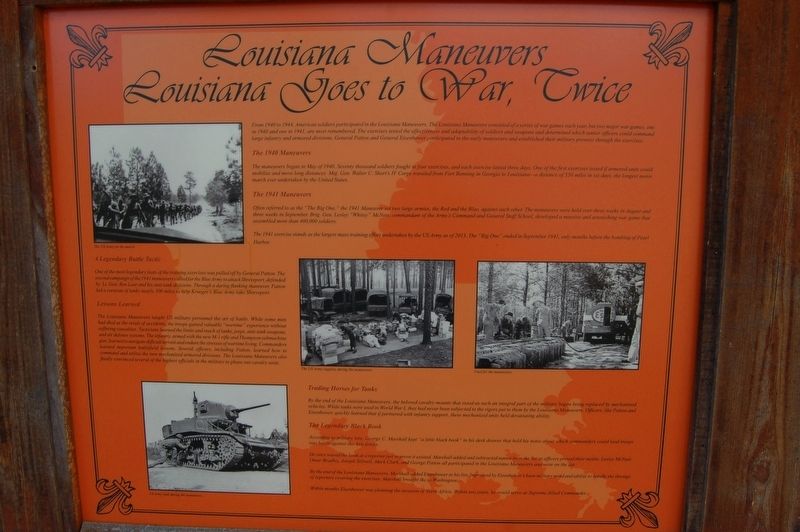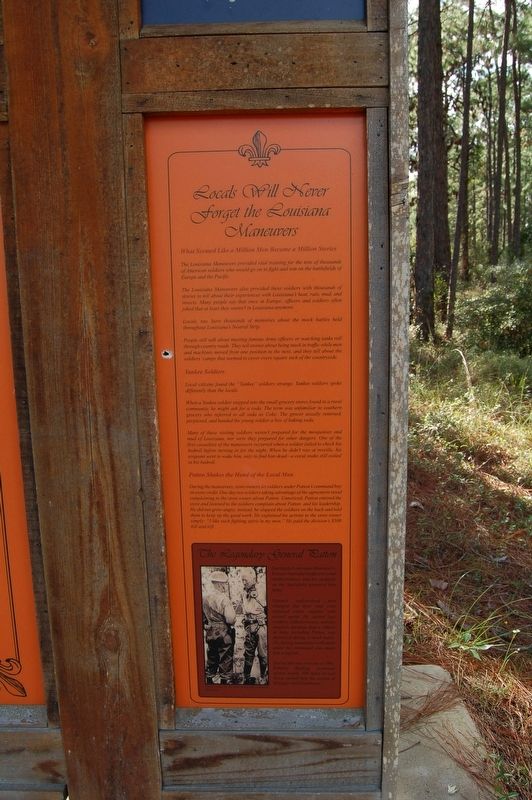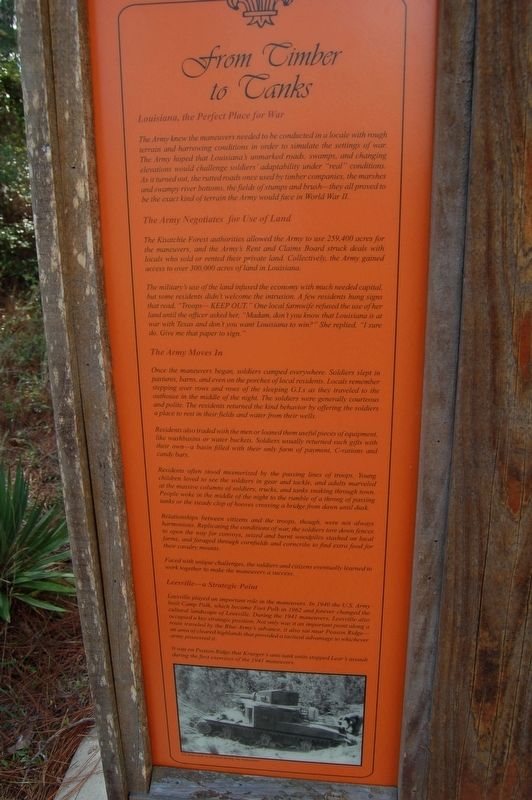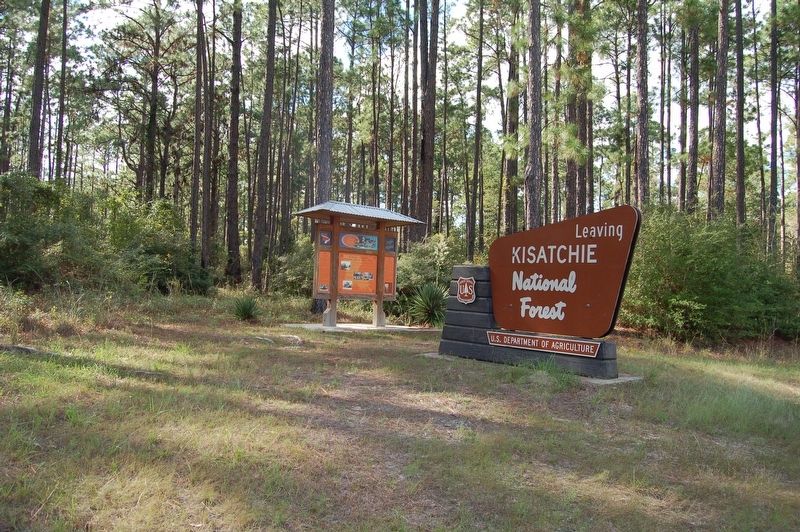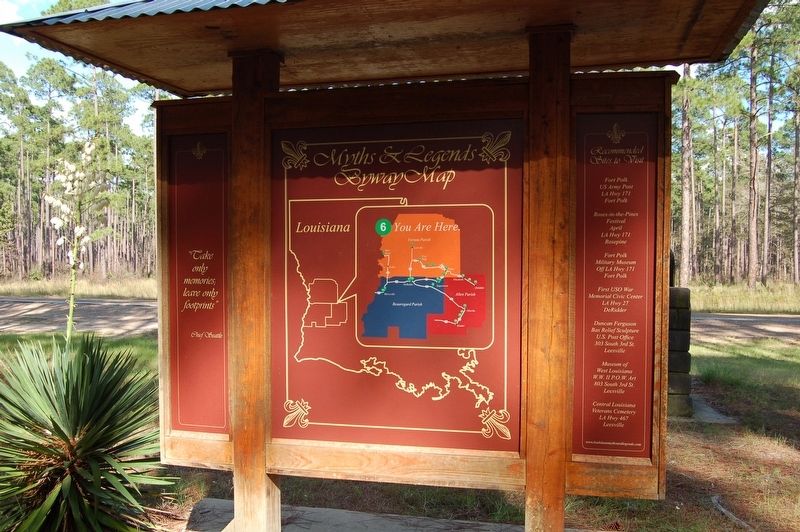Leesville in Vernon Parish, Louisiana — The American South (West South Central)
Louisiana Maneuvers Louisiana Goes to War, Twice
Myths and Legends - Vernon Parish
Inscription.
From 1940 to 1944, American soldiers participated in the Louisiana Maneuvers. The Louisiana Maneuvers consisted of a series of war games each year, but two major war games, one in 1940 and one in 1941, are most remembered. The exercises tested the effectiveness and adaptability of soldiers and weapons and determined which senior officers could command large infantry and armored divisions. General Patton and General Eisenhower participated in the early maneuvers and established their military prowess through the exercises.
The 1940 Maneuvers
The maneuvers began in May of 1940. Seventy thousand soldiers fought in four exercises, and each exercise lasted three days. One of the first exercises tested if armored units could mobilize and move long distances. Maj. Gen. Walter C. Short's IV Corps traveled from Fort Benning in Georgia to Louisiana-a distance of 550 miles in six days, the longest motor march ever undertaken by the United States.
The 1941 Maneuvers
Often referred to as the "The Big One," the 1941 Maneuver set two large armies, the Red and the Blue, against each other. The maneuvers were held over three weeks in August and three weeks in September. Brig. Gen. Lesley "Whitey" McNair, commandant of the Army's Command and General Staff School, developed a massive and astonishing war game that assembled more than 400,000 soldiers.
The 1941 exercise stands as the largest mass-training effort undertaken by the US Army as of 2013. The "Big One" ended in September 1941, only months before the bombing of Pearl Harbor.
A Legendary Battle Tactic
One of the most legendary feats of the training exercises was pulled off by General Patton. The second campaign of the 1941 maneuvers called for the Blue Army to attack Shreveport, defended by Lt. Gen. Ben Lear and his anti-tank divisions. Through a daring flanking maneuver, Patton led a caravan of tanks nearly 300 miles to help Krueger's Blue Army take Shreveport.
Lessons Learned
The Louisiana Maneuvers taught US military personnel the art of battle. While some men had died as the result of accidents, the troops gained valuable "wartime" experience without suffering casualties. Tacticians learned the limits and reach of tanks, jeeps, anti-tank weapons, and air defense systems. The infantry, armed with the new M-1 rifle and Thompson submachine gun, learned to navigate difficult terrain and endure the stresses of wartime living. Commanders learned important battlefield lessons. Several officers, including Patton, learned how to command and utilize the new mechanized armored divisions. The Louisiana Maneuvers also finally convinced several of the highest officials in the military to phase out cavalry
units.
Trading Horses for Tanks
By the end of the Louisiana Maneuvers, the beloved cavalry mounts that stood as such an integral part of the military began being replaced by mechanized vehicles. While tanks were used in World War I, they had never been subjected to the rigors put to them by the Louisiana Maneuvers. Officers, like Patton and Eisenhower, quickly learned that if partnered with infantry support, these mechanized units held devastating ability.
The Legendary Black Book
According to military lore, George C. Marshall kept "a little black book" in his desk drawer that held his notes about which commanders could lead troops into battle against the Axis forces.
He once waved the book at a reporter just to prove it existed. Marshall added and subtracted names from the list as officers proved their mettle. Lesley McNair, Omar Bradley, Joseph Stilwell, Mark Clark, and George Patton all participated in the Louisiana Maneuvers and were on the list.
By the end of the Louisiana Maneuvers, Marshall added Eisenhower to his list. Impressed by Eisenhower's keen military mind and ability to handle the throngs of reporters covering the exercises, Marshall brought Ike to Washington.
Within months Eisenhower was planning the invasion of North Africa. Within two years, he would serve as Supreme Allied Commander.
Locals Will Never Forget the Louisiana Maneuvers
What Seemed Like a Million Men Became a Million Stories
The Louisiana Maneuvers provided vital training for the tens of thousands of American soldiers who would go on to fight and win on the battlefields of Europe and the Pacific.
The Louisiana Maneuvers also provided these soldiers with thousands of stories to tell about their experiences with Louisiana's heat, rain, mud, and insects. Many people say that once in Europe, officers and soldiers often joked that at least they weren't in Louisiana anymore.
Locals, too, have thousands of memories about the mock battles held throughout Louisiana's Neutral Strip.
People still talk about meeting famous Army officers or watching tanks roll through country roads. They tell stories about being stuck in traffic while men and machines moved from one position to the next, and they tell about the soldiers' camps that seemed to cover every square inch of the countryside.
Yankee Soldiers
Local citizens found the "Yankee" soldiers strange. Yankee soldiers spoke differently than the locals.
When a Yankee soldier stepped into the small grocery stores found in a rural community, he might ask for a soda. The term was unfamiliar to southern grocers who referred to all soda as Coke. The grocer usually returned, perplexed, and handed
the young soldier a box of baking soda.
Many of these visiting soldiers weren't prepared for the mosquitoes and mud of Louisiana, nor were they prepared for other dangers. One of the first casualties of the maneuvers occurred when a soldier failed to check his bedroll before turning in for the night. When he didn't rise at reveille, his sergeant went to wake him, only to find him dead-a coral snake still coiled in his bedroll.
Patton Shakes the Hand of the Local Man
During the maneuvers, store owners let soldiers under Patton's command buy on store credit. One day two soldiers taking advantage of the agreement stood complaining to the store owner about Patton. Unnoticed, Patton entered the store and listened to the soldiers complain about Patton and his leadership. He did not grow angry; instead, he slapped the soldiers on the back and told them to keep up the good work. He explained his actions to the store owner simply: "I like such fighting spirit in my men." He paid the division's $500 bill and left.
The Legendary General Patton
During the Louisiana Maneuvers, Patton's hatred of inefficiency and Ineffectiveness and his audacity on the battlefeld garnered him fame.
Patton's well-trained men changed flat tires and even replaced entire engines with record speed. He cursed lazy soldiers,
stalled convoys, and any
umpire's decision that a vehicle
or man, including Patton, was
destroyed during a mock battle.
His daring maneuvers with tanks
under his command also made
him a legend.
During the last exercise of 1941. Patton's flanking maneuver across nearly 300 miles of east Texas earned him the esteem of Krueger and Eisenhower.
From Timber to Tanks
Louisiana, the Perfect Place for War
The Army knew the maneuvers needed to be conducted in a locale with rough terrain and harrowing conditions in order to simulate the settings of war. The Army hoped that Louisiana's unmarked roads, swamps, and changing elevations would challenge soldiers' adaptability under "real" conditions. As it turned out, the rutted roads once used by timber companies, the marshes and swampy river bottoms, the fields of stumps and brush-they all proved to be the exact kind of terrain the Army would face in World War II.
The Army Negotiates for Use of Land
The Kisatchie Forest authorities allowed the Army to use 259,400 acres for the maneuvers, and the Army's Rent and Claims Board struck deals with locals who sold or rented their private land. Collectively, the Army gained access to over 300,000 acres of land in Louisiana.
The military's use of the land infused the economy with much needed capital, but some residents didn't welcome the intrusion. A few residents hung signs that read, "Troops-KEEP OUT." One local farmwife refused the use of her land until the officer asked her, "Madam, don't you know that Louisiana is at war with Texas and don't you want Louisiana to win?" She replied, "I sure do. Give me that paper to sign."
The Army Moves In
Once the maneuvers began, soldiers camped everywhere. Soldiers slept in pastures, barns, and even on the porches of local residents. Locals remember stepping over rows and rows of the sleeping G.I.s as they traveled to the outhouse in the middle of the night. The soldiers were generally courteous and polite. The residents returned the kind behavior by offering the soldiers a place to rest in their fields and water from their wells.
Residents also traded with the men or loaned them useful pieces of equipment, like washbasins or water buckets. Soldiers usually returned such gifts with their own a basin filled with their only form of payment, C-rations and candy bars.
Residents often stood mesmerized by the passing lines of troops. Young children loved to see the soldiers in gear and tackle, and adults marveled at the massive columns of soldiers, trucks, and tanks snaking through town. People woke in the middle of the night to the rumble of a throng of passing tanks or the steady clop of hooves crossing a bridge from dawn until dusk.
Relationships between citizens and the troops, though, were not always harmonious. Replicating the conditions of war, the soldiers tore down fences to open the way for convoys, seized and burnt woodpiles stashed on local farms, and foraged through cornfields and corncribs to find extra food for their cavalry mounts.
Faced with unique challenges, the soldiers and citizens eventually learned to work together to make the maneuvers a success.
Leesville-a Strategic Point
Leesville played an important role in the maneuvers. In 1940 the U.S. Army built Camp Polk, which became Fort Polk in 1962 and forever changed the cultural landscape of Leesville. During the 1941 maneuvers, Leesville also occupied a key strategic position. Not only was it an important point along a route traveled by the Blue Army's advance, it also sat near Peason Ridge- an area of cleared highlands that provided a tactical advantage to whichever army possessed it.
It was on Peason Ridge that Krueger's anti-tank units stopped Lear's assault during the first exercises of the 1941 maneuvers.
Erected by Louisiana Myths and Legends Byways.
Topics and series. This historical marker is listed in this topic list: War, World II. In addition, it is included in the Louisiana Myths & Legends Byway series list.
Location. 31° 1.053′ N, 93° 11.385′ W. Marker is in Leesville, Louisiana, in Vernon Parish. Marker is on Pitkin Highway (State Highway 10) one mile south of Lookout Road, on the right when traveling east. Touch for map. Marker is in this post office area: Leesville LA 71446, United States of America. Touch for directions.
Other nearby markers. At least 8 other markers are within 3 miles of this marker, measured as the crow flies. Civilian Conservation Corps (approx. 0.2 miles away); Wolf Rock Cave In Kisatchie National Forest (approx. one mile away); The Seventh Armored Division (approx. 2.1 miles away); Camp Polk Heritage Families (approx. 2˝ miles away); Peason Ridge Heritage Families (approx. 2˝ miles away); Second Brigade Soldiers (approx. 2˝ miles away); 5th Infantry Division (Mechanized) (approx. 2˝ miles away); Fort Polk (approx. 2˝ miles away).
Credits. This page was last revised on November 24, 2022. It was originally submitted on November 24, 2022, by Cajun Scrambler of Assumption, Louisiana. This page has been viewed 187 times since then and 19 times this year. Photos: 1, 2, 3, 4, 5. submitted on November 24, 2022, by Cajun Scrambler of Assumption, Louisiana.
